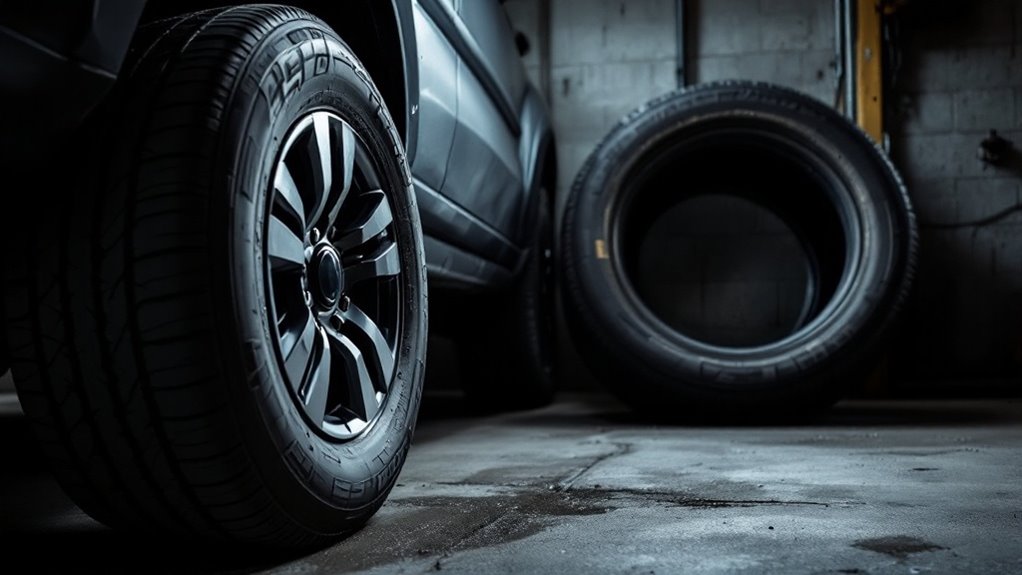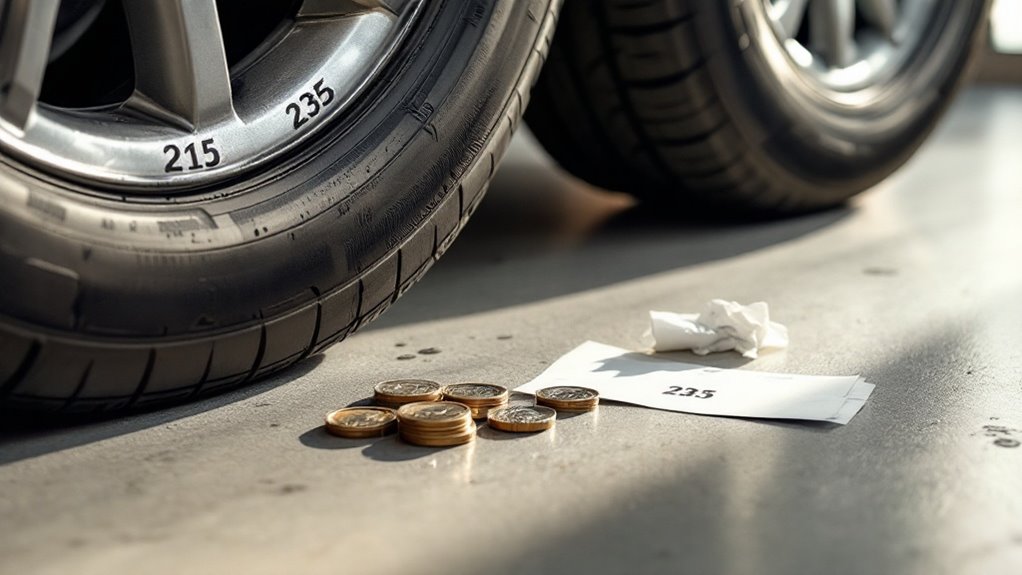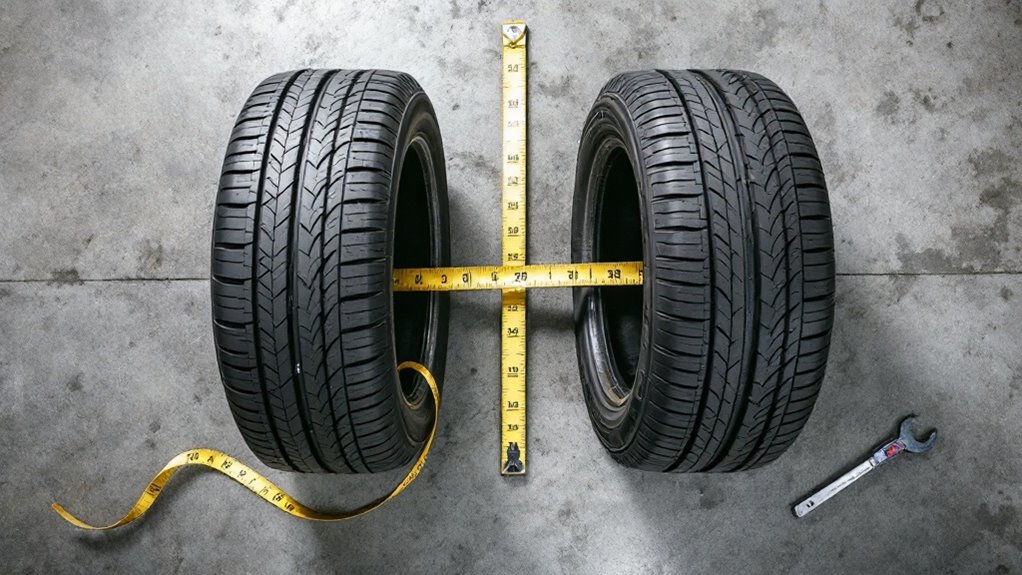Can I Change My 215 To 235 Tire Size
This post contains affiliate links. As an Amazon Associate, we earn from qualifying purchases.
Can you switch from 215/75-R15 to 235/75-R15 tires? Yes, it’s possible! First, check if your vehicle’s wheel wells have enough space. You don’t want tires rubbing on fenders. Also, look at the suspension parts for clearance. Keep the diameter difference under 3%. This helps avoid braking problems. Make sure brake calipers have enough room too.
Wider 235 tires might use more fuel. They can also mess with speedometer readings. Always double-check these details for safety. A small mistake could cause big issues. Stick to these tips for a smooth change. Your ride deserves the best care!
Essential Facts in 30 Seconds
- You can switch from 215/75-R15 to 235/75-R15 tires since both fit 15-inch rims.
- Ensure sufficient wheel well space to avoid rubbing with the larger 235 tires.
- Keep diameter variance within 3% to prevent brake issues.
- Wider 235 tires enhance traction but may reduce fuel efficiency.
- Check alignment and speedometer accuracy after changing tire size.
Understanding Tire Size Differences
Tire size changes can affect your car’s performance and safety. Let’s break it down.
Compare tires like 215/75-R15 and 235/75-R15 for clear differences. The 235 tire is wider by a bit. This changes how your car looks and fits. Both tires have the same sidewall height ratio. Yet, the 235 tire’s diameter is bigger by 1.18 inches. This impacts the total circumference too. Choosing the right tire size is crucial for optimal vehicle performance.
Both tires match 15-inch rims, so no worries there. Still, other things count a lot. Bigger tires might handle more load or weight. They could also have different tread for better grip. Additionally, the larger diameter affects speedometer accuracy due to the difference in revolutions per mile.
But watch out for some downsides. Larger tires may wear out faster over time. Fuel use might go up due to extra resistance. Handling on roads can feel different as well.
For old cars, check charts to find modern tire matches. This helps avoid fit problems easily. Stick to simple choices for the best results. Your car deserves the right tire size!
Performance Impacts of Switching Sizes

Tire size changes, like 215/75-R15 to 235/75-R15, affect your vehicle’s performance.
Wider 235 tires give better traction on dry and wet roads. They create a bigger contact patch with the ground. This helps with grip and handling during sharp turns. You get stability in sporty driving too. Acceleration and braking also feel more responsive. Research suggests that a wider tire can offer about a 3.7% grip increase due to the increased section width. Additionally, this increase in width can lead to a larger contact patch with the road, which enhances overall performance.
But wider tires have some downsides to think about. They often increase fuel use a bit. Expect more road noise from the larger tread. Narrower 215 tires offer a quieter ride. They save more fuel as well. Yet, they provide less grip on roads.
Think about your needs—traction or saving gas? Pick the size that matches your driving style. Balance performance with comfort for the best result.
Compatibility and Installation Checks

Are you switching to a bigger tire size? Let’s make sure it fits right!
First, check the space in your wheel well. A wider tire, like 235 instead of 215, shouldn’t rub. You don’t want it touching the fenders.
Next, look at your suspension area. Bigger tires mustn’t hit shocks or struts. This matters a lot during turns or with heavy loads.
Then, think about your brakes. A larger tire shouldn’t block the caliper. It mustn’t mess with heat release either.
Safety comes first, always! Keep these checks in mind. Your ride stays smooth and secure. Also, ensure the tire diameter stays within 3% variance to avoid potential brake issues.
Verify Wheel Well Space
Let’s check the wheel well space for a tire upgrade. You’re moving from a 215 mm to a 235 mm tire. That’s a 20 mm difference, or about 0.79 inches wider.
Measure the space carefully, both side to side and up and down. Aim for 1-2 inches of extra room around the tire. This stops rubbing and keeps things safe.
Think about these risks. First, tight space can damage tires and fenders. Second, bad clearance messes up handling on turns or bumps. Third, you might need to cut fenders for a good fit.
Take a close look at the area. Check from the fender edge to inner parts. See if changes are needed for this upgrade. Ensure you have enough wheel well space for proper tire fitment.
Stay safe and measure twice!
Check Suspension Clearance
Got new tires? Let’s check suspension clearance for your upgrade from 215 mm to 235 mm. Wider tires need space. Look at the gap between tires and suspension parts. Check arms and struts closely. Make sure nothing rubs or gets damaged. This is super important for tight setups.
Now, peek at vertical space. See if tires touch shocks or springs. Test this during full compression, like over big bumps. No contact? Great! Wider tires change how your car handles. They add more side forces. It’s also essential to ensure that the proper tire fitment is maintained to avoid any adverse effects on vehicle performance.
Do a quick compression test. Mount the 235 tires and watch for issues. Check wheel offset too. Rim width should be 8.5 to 9 inches. This keeps parts safe. Your car stays strong and ready to roll!
Assess Brake Compatibility
Upgrading tires from 215 mm to 235 mm? Check brake compatibility first! A small change in tire size can hurt braking. Even a 3% difference might cause issues. Safety on the road matters most.
Think about these key points for a safe ride:
- Size Problems: Wrong tire diameter can slow down braking.
- ABS Check: Make sure ABS works with new tires. No risks!
- Load Safety: New 235 tires must handle your car’s weight.
Additionally, remember that tire fitment compatibility is critical for ensuring optimal vehicle performance and safety. Always look at the manufacturer’s rules for tire fit. Stay safe every mile you go!
Potential Challenges and Risks

Think about clearance problems with bigger tires. A jump from 205/55R16 to 225/60R16 can cause rubbing. Tires might scrape fenders or suspension. This leads to damage fast.
Pay attention to your speedometer too. A different tire size messes up readings. You could see 60 mph but go 65 mph. That risks trouble with the law.
Also, check alignment often. Wrong tire sizes wear unevenly. You’ll need realignments to stay safe. This prevents pricey repairs down the road.
Additionally, ensure you consider manufacturer recommendations for tire sizing to avoid safety risks.
Stick to these tips for better driving!
Clearance and Rubbing Issues
Think about tire size changes carefully. Bigger or wider tires, like moving from 215 to 235, can cause problems. They might rub against fenders or suspension parts. This rubbing risks uneven tire wear and even blowouts.
Check your wheel well space first. Look closely during sharp turns or with heavy loads. You might need wheel spacers or fender trimming.
Picture these troubles clearly. Rubbing can lead to expensive repairs. Safety becomes a real concern with damaged tires. Stress builds up over legal rules and warranty issues. Additionally, consider the impact of tire width on your vehicle’s performance in various conditions, especially in snow.
Always keep tires aligned properly. Inspect them often for any damage. Make sure changes follow local laws. Stay safe and avoid big problems.
Speedometer Accuracy Concerns
Ever wonder how tire size messes with your speedometer? Let’s break it down. Changing from a 215 to a 235 tire matters a lot. Bigger tires have a larger circle. This means fewer spins per mile. Your speedometer then shows a lower speed. You might drive faster than you think!
Why stress about this small change? It’s a big deal. Wrong speed readings can trick you. You could get speeding tickets on highways. Or drive too slow in the city. Even your odometer gets it wrong. It counts fewer miles on long trips. This messes up maintenance timing. Plus, resale value drops with odd mileage data.
Check this simple table for real effects:
| Situation | Speedometer Problem |
|---|---|
| Highway drive | Shows less speed, risks fines |
| City streets | Too slow, annoys other drivers |
| Long journey | Counts less miles, wrong data |
| Car check-ups | Bad mileage, late repairs |
| Selling your car | Wrong miles, buyers lose trust |
Act fast to fix this issue. Recalibrate your speedometer now. Accurate speed readings are crucial for safety and compliance, so stay safe and avoid trouble.
Alignment Adjustment Needs
Changing tire size messes with your speedometer. It also impacts your vehicle’s alignment. Upsizing from 215 to 235 width needs extra care.
Alignment matters a lot with wider tires. They change how tires touch the road. This stresses suspension and steering parts. Skip this, and tires wear unevenly. Safety drops too.
Think about these risks to see why alignment counts:
- Uneven Wear: Bad alignment wears tires out fast.
- Poor Control: Misalignment pulls your car. It’s hard to steer.
- Danger on Road: Shaky handling raises crash risks for everyone.
Keep an eye on tire pressure. It affects alignment a lot. Go to a pro for help. They adjust camber, caster, and toe settings. This matches the new tire size. Your car stays stable and safe. Additionally, a proper alignment ensures that the tire footprint remains optimal for maximum traction and handling.
Financial Aspects of Tire Upgrades

Think about the money side of upgrading tires. Costs can pile up fast. Beyond the tire price, other fees sneak in. Switching from 215 to 235 tires means higher costs. Expect to pay $50 to $200 per tire.
Add $15 to $25 for installation each time. Don’t forget disposal fees—$2 to $5 per tire.
Plan your budget with care. Look at your driving needs first. Set aside cash for maintenance like tire rotations.
Need help paying? Try financing with Affirm or PayPal. They offer easy payment plans. Premium tires become possible, no matter your budget.
Check this quick cost list:
- Tire Cost: $50–$200 each
- Installation: $15–$25 per tire
- Disposal Fee: $2–$5 per tire
Consider the bigger picture too. Larger tires might need suspension changes. Fuel costs could rise as well. Additionally, proper tire selection is crucial for maintaining vehicle handling and stability.
Think smart about money. Economic factors or credit limits might affect your choice.
Safety Guidelines for Size Changes

Safety comes first with tire size changes for your car. Upgrading from 215 to 235 needs careful thought. Stick to what the car maker says in the manual. Wrong tire sizes can mess up braking or control systems. This might cause big dangers on the road.
Think about these scary risks with wrong tire sizes:
- Bad Handling Dangers: Braking takes longer and crashes can happen.
- Wrong Speed Readings: Speedometer shows wrong numbers and tricks you.
- Early Breakdowns: Extra stress breaks car parts too soon.
Always ask a trusted mechanic for help. Make sure load limits and tire pressure match the maker’s rules. Stay safe by double-checking everything!
Frequently Asked Questions
Will Changing to 235 Affect My Warranty?
Got questions about tire size changes and warranty? No need to stress! Switching to 235 tires usually won’t void your coverage. Only if the new size hurts performance or breaks parts. Car makers must show proof of damage to deny claims. So, most times, you’re totally safe. Stick with recommended sizes for best results. Check your manual or ask a pro. That way, you avoid any risks. Keep your ride smooth and worry-free!
Can I Mix 215 and 235 Tires?
Imagine a car wobbling on a bumpy road. Don’t mix 215 and 235 tires. It messes up your car’s balance. You get uneven wear and risky handling. Always use the same tire size. Data shows mixed sizes cut tire life by 20%. Keep rides smooth and safe. Stick to one size for best results.
How Does Tire Size Impact Resale Value?
Tire size matters a lot for resale value. Bigger tires often make performance cars look cooler. They can improve how the car drives too. Buyers love that sporty feel. But wrong tire sizes scare them off fast. Stick to matching sizes for better resale. Studies show mismatched tires drop value by 5-10%. Keep it simple and right. That way, your car stays attractive to buyers.
Are There Legal Restrictions for Tire Size?
Think ahead and save trouble later. Always check tire size rules first. Stay safe and follow the law. Bigger or smaller tires might cause problems. Some places ban certain sizes for safety. Data shows wrong tires lead to accidents. Keep your car legal and secure. Ask a mechanic for the right fit. Avoid fines by knowing the rules. Stay smart on the road today.
Does Tire Size Affect Insurance Premiums?
Tire size can change your insurance costs. Bigger tires often mean higher premiums. Insurers think large tires raise risks. Repair costs might go up too. Tell your insurer about any tire changes. Stay safe and avoid surprises. Check with them for exact details.
Conclusion
Got a question about switching from 215 to 235 tire size? Let’s dive right in! This change can work, but check your car first. Tire size affects speed, handling, and fuel use. A 235 tire is wider by 20 millimeters. That means more grip on the road. But, it might rub against your car’s fenders. Measure the space to be sure. Your speedometer may show wrong numbers too. Talk to a mechanic for advice. Check your car manual for safe sizes. Costs can go up with bigger tires. Think about that before you decide. Stay safe and drive smart always!
